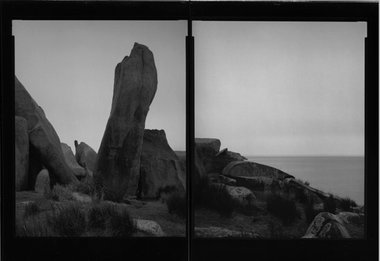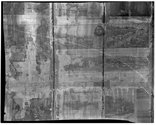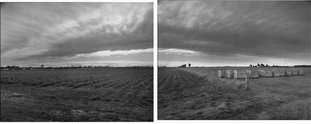John Hurrell – 27 February, 2013
What is interesting is the amount of travelling around this country Adams has done over the years. The more remote spots don't seem to have evaded him, for his curiosity about historical events has led him to record a vast range of landforms, many moody and dramatic, even those. Yet these are not his sole form of photographic expression, as his well known coloured architectural and tattoo (more overtly community oriented) works show.
The eleven ‘documentary’ landscape images here from Mark Adams‘ photographic archives go back to the late seventies - as created negatives, not prints - and though linked firmly to certain key events in particular locations in this country’s social history, are just as much about Romanticism, light, weather, geology and camera technology as landscape. And as ‘documentary’ is the convenient heading the work is presented under, certain narratives and cultural foci provide three varieties of conceptual underpinning: namely sites linked to the signing of the Treaty of Waitangi, Ngai Tahu sacred sites, and coastal sites visited by Cook.
One photograph doesn’t quite fit in this explanation, but as a 1977 image it marks the start of the artist’s detailed exploration of Aotearoa’s ‘complicated colonial histories’: an exposed wall of an old villa in Maungakaramea in Northland where the April 8 1918 edition of Auckland Weekly Newspaper provided the wallpaper. We see sheets of tattered and layered newsprint, with images of the Tuhoe prophet Rua Kenana and his circular temple Hiona peeping through, a vertical archaeology.
Adams’ Treaty of Waitangi signing sites start with Te Tii Marae Waitangi, Bay of Islands, Hokianga Habour, Rakiura (Stewart) Island and then Rangitoto Ki Te Tonga (D’Urville) Island. The image of Rakiura Island shows Adams’ passion for historical research, with his own interesting observations written on the print and in the gallery catalogue. His comments note that Captain Hobson instructed Major Thomas Bunbury of the HMS Herald ‘to assemble the chiefs whenever an opportunity presents itself, and expound to them the principles on which Her Majesty proposes to extend to this country the advantages of a settled form of civil government, and to obtain the signatures of such as may not have already given their adherence,’ but that Bunbury on Rakiura Island went ahead proclaiming British sovereignty by ‘right of discovery’ of Captain Cook, without visiting any of the Maori settlements on the island.
The other series consists of sites connected to Cook’s second voyage (1772-1775) usually where William Hodges (1744-1797) did sketches that later on back in London he converted into oil paintings. Two of Adam’s images in particular, 17.5.1975 View in Pickersgill Harbour after William Hodges, and 10.8.1998 Indian Island, after William Hodges’ “View in Dusky Bay” are directly connected to two of Hodges‘ most well known paintings.
What is interesting is the amount of travelling around this country Adams has done over the years. The more remote spots don’t seem to have evaded him, for his curiosity about historical events has led him to record a vast range of landforms, many moody and dramatic, even those. Yet these are not his sole form of photographic expression, as his well known coloured architectural and tattoo (more overtly community oriented) works show - only a dominant preoccupation. A modest but fascinating survey.
John Hurrell







 Two Rooms presents a program of residencies and projects
Two Rooms presents a program of residencies and projects Advertising in this column
Advertising in this column



This Discussion has 0 comments.
Comment
Participate
Register to Participate.
Sign in
Sign in to an existing account.